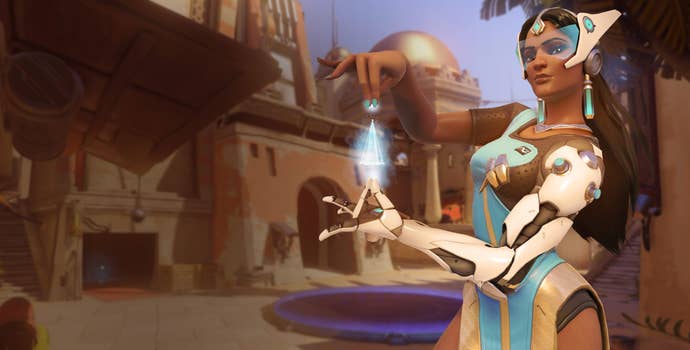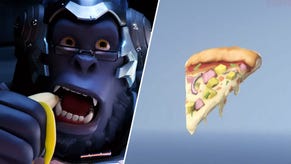The Evolution of Symmetra, Overwatch's Most Changed and Divisive Character
You either love her or you hate her.
This article first appeared on USgamer, a partner publication of VG247. Some content, such as this article, has been migrated to VG247 for posterity after USgamer's closure - but it has not been edited or further vetted by the VG247 team.
If you ask Overwatch players what they think about Symmetra, everybody’s got a different answer. She’s a cheap pick for someone who can’t aim, some will say, or a trump card on defense; she's an essential part of the team or the worst decision you could ever make. Parts of her fit into every role there is—she’s a builder, defense, support, and DPS—but she sits on the sidelines more than any other character. She's the least picked, the most despised. She’s a misfit who captured my heart when Overwatch launched in May 2016, and, call me a masochist, but her roller coaster cycle of development and ubiquitous hate have only made me love her more.
Overwatch was the first multiplayer shooter I picked up since Team Fortress 2, lulling me in with its similarly colorful class of characters combined with a focus on diverse representation. As I flicked through the familiar classes, I paused on Symmetra, smiling because she reminded me of my best friend, a daughter of Sri Lankan immigrants. It was the hair, I think: so thick it’d almost look coarse if it weren’t for the healthy sheen.

I noted the similarity almost subconsciously and went to move on, but a question stopped me. Had I ever played a South Asian character before? Realizing the answer was “No,” I became possessed by a new determination. “Well, we’ve got to fix that,” I thought, picking her without a second thought.
And with that innocuous choice, I found a character whose Support classification was all too misleading because she filled a role uniquely her own. As some kind of hybrid between a builder and defense character, her initial kit looked entirely different from what it is now in 2018.
Her Proton Projector, of which she has a modified version today, auto-locked onto enemies and gradually built up damage with her primary fire while her alternate fire charged up slowly and fired similarly sluggish orbs. And while her darling turrets may still be familiar to players now, she could only carry three of them around at a time with an agonizingly long cooldown of 12 seconds, so placing her maximum of six on the map took a significant chunk of time. Luckily, her ultimate—a teleporter that linked back to the spawn room—came equipped with a hefty 200 health points, so destroying it took more than a single shot from the errant Tracer or Pharah.
While her abilities made her a tricky play in offensive situations, she easily locked down points on defense, killing off waves of enemies with her strategically placed turrets and bulking up teammates with individual Photon Shields. Hanamura, Temple of Anubis, and Volskaya Industries, with their high walls and multiple hidey holes for turrets, transform into impenetrable fortresses, especially when teamed up with a traditional builder like Torbjorn. Control stages with boxed-in capture points also proved equally infuriating, as it’s hard to take a point you can’t step foot on without dying.
But time proved the enemy of Symmetra. Play enough matches as her or against her and you start to learn the hidden corners best fitted for turrets and teleporters. In Quick Play, you could still occasionally catch the enemy by surprise, but against multi-stacks where opponents can call out turret locations to one another, a push by Pharah or Junkrat could take your darlings out from afar faster than you could place them. And even an armada of six turrets barely registered against the wrath of Winston’s Tesla Cannon. One-on-one rounds with squishier characters proved equally disastrous, as nothing in her kit made a quick escape or defense possible. As such, it barely registered as a surprise when later in 2016 Blizzard revealed she was the least played character of Overwatch’s original 21.

A Second Chance to Make Her Mark
Symmetra’s first major rework came barely six months after the game’s release in December of 2016. Alongside Overwatch’s first Winter Wonderland event, Blizzard gifted the builder with a second ultimate: a Shield Generator for situations when teleporting the team wouldn’t be much of a game changer.
"[W]e noticed players would often switch off of Symmetra once they found themselves in a situation where her Teleporter wasn’t as useful,” Blizzard explained in patch notes.
Symmetra mains were all too familiar with this reversal. On Assault maps, being pushed back to the second point whether by enemy assault or an unfortunate backfill drastically limited the range of her ultimate. Her new Shield Generator seemed custom-built for more of these circumstances as well as a helpful contender for offensive pushes, increasing her versatility and —at least, Blizzard hoped—how often players picked her.
To help with that squishy health, the company replaced her shield-granting ability with the more active Photon Barrier, a beefy energy barrier that glides forward until it breaks on contact. While not the most practical given its limited direction, it blocked enemy onslaughts and ultimates alike when used strategically. My favorite: Using it to nullify an enemy D.Va’s ult in the last second before it explodes, then downing her before she can summon a new mech.
This patch also saw minor tweaks to the rest of her kit, but it was these new abilities that really changed the feel of playing Symmetra. She went from being a single-use trump card on defense to a more balanced support, someone who could hold her own in battle until her teammates arrived or her turrets chipped away the last of her opponent’s health. And, finally, her kit was actually useful on attack. Yet even with her new upgrade, common criticisms remained, particularly a question that had haunted her since launch: Why is there a support character who can’t even heal?
When news of her rework spread, the question cropped up again and again in developer interviews. “We’re not looking at making Symmetra a healer. What we’re looking at is making her more viable in more situations,” Overwatch director Jeff Kaplan said in a community update at the time.
But some fans still weren’t happy. During this iteration, griefing on Symmetra proliferated; picking her robbed the team composition of a valuable healer position, some argued, and mains who chose her regardless of the situation were assailed with allegations of intentionally throwing the game. As if to fuel the animosity, trolls began doing just this, using the support hero as a scapegoat for their poor sportsmanship.
The situation came to a head as players began banding together to report Symmetra players en masse. Their reasoning: Refusing to abide by popular meta and insta-picking Symmetra disrupts gameplay and is a sign of poor teamwork. Both are punishable offenses in Overwatch’s reporting system, and led to several bans for Symmetra mains.
“Once people found out they could report me and get me suspended,” one of the top Symmetra players and streamers Stevooo told Kotaku in an interview last year, “almost every game I’ve been in recently someone has told everyone in the game to report me to get me banned.”
The final lynchpin came as the Overwatch League season progressed and pros had yet to put any playtime in as Symmetra. This only cemented her haters’ assertions that she was a throw character, not meant for any kind of serious competition.

Third Time's the Charm... Hopefully
Blizzard’s newest update in June brought with it so many monumental changes, some players are already calling it "the patch that saved Overwatch." And amidst the hubbub and clamor surrounding this major development, yet another new Symmetra emerged after one of the largest character reworks Overwatch has ever seen, complete with a new hero class: “Damage.” With this revamped version, Blizzard took the impetus behind her first update and cranked her versatility even further.
“Now that Symmetra is no longer a support hero, she is expected to be able to dish out heavy damage, and these changes allow for her to do so,” the company stated in its patch notes.
It’s no stretch to say this latest update changed Symmetra completely. Her Photon Projector? No more auto-locking murder beam; you’ve got to aim it, up to a new maximum damage of 180. While hitting that zenith requires a little more skill now, aiming at shields charges up the beam faster while generating ammo. And her alternate fire? Now it charges and shoots faster, spitting out bursting projectiles that, when fully charged, hurt as much as one of Pharah’s rockets to the face. Her static turrets function as projectiles as well so you can shoot behind the enemy team to slow them down while you chip away their health, with the caveat that she now carries half her usual amount.
And her original ultimate, that iconic teleporter? Now a temporary ability capable of placement anywhere, and easily the biggest game-changing feature of Symmetra’s rework. Instead of an ace up your sleeve, it’s now a dynamic part of the match by boosting mobility akin to Lucio’s Crossfade but in three dimensions. Raining down damage from above is no longer limited to certain characters, as now anyone can access the high ground on multi-level maps like Temple of Anubis or Hollywood, transforming how players use powerful but lumbering characters like Orisa or Bastion. And a Teleporter placed behind the enemy team allows you to stage an assault from both fronts simultaneously, made even more fun by bouncing a turret-form Bastion back and forth between warps.
And as if her role wasn’t nuanced enough, these new abilities also add a layer of stealth to Symmetra’s gameplay, punctuating her new battle-ready emphasis. Being able to instantly transport D.Va’s exploding mech or Junkrat’s Rip-tire behind enemy lines makes ults with tells players have long since memorized become a frightening surprise again. And while a bit of sneaking has always been required to replace destroyed turrets, their newfound mobility can render any surface dangerous to approach at a moment’s notice, completely throwing off a team’s momentum.
While strategically useful, I’ll admit these stealth components don’t really help her reputation as being a pick for cheap kills. But that doesn’t change how satisfying it is to fire a turret behind a fleeing enemy and chip away their last few health points, or completely refocus an enemy’s attention on the turret-filled wall behind them. It complements the rest of her kit perfectly: With your Teleporter, you direct your team, and with your turrets, you direct the enemy team’s attention.
Despite all Blizzard has done to make Symmetra more versatile, her new ultimate—a massive, map-splicing version of her Photon Barrier—perpetuates her reputation for situational usefulness. With its static nature, it becomes tricky to line it up to a position where it’ll benefit the entire team, especially on fast-paced escort maps. You may gawk at its 5,000 health points, but that cap almost feels unnecessary given its 15-second duration; I’ve yet to see an enemy team break it down before it disappears. And while it can be great for dividing a battlefield in tight quarters, such as the second points on Volskaya Industries or Temple of Anubis, it seems most useful is in nullifying enemy ults.
Unfortunately, while the Photon Barrier is great against slower ults like Junkrat’s and D.Va’s, more often than not I found myself getting sliced open by a Genji or gunned down by a Soldier before she had time to lay down it down completely. Getting the timing right really comes down to anticipating an enemy’s actions, making it more viable among seasoned players used to this strategy rather and less so among casuals.
It’s a bit ironic seeing Symmetra’s advantageous ult evolve into something so situationally useful, but at the same time, it fits with Blizzard MO for her since the game’s launch. She’s a constantly changing presence, one that even her developers don’t entirely know how to use. Instead, they watch her players, study how we play this misfit of a character, and tweak her accordingly, as if we the fans have a hand in sculpting her development.
For those of us who have stuck through every change—from a Torbjorn-lite builder to this new mobile support assassin, from a pick best at locking down a defensive hold to a character who can finally lay down DPS on offense—it’s been rough. But it's satisfying to stick by the most changed character in Overwatch.
Like with her other builds, the development of new strategies to best use her notoriously unique skill set will be an ongoing process in the months to come. But who knows, with her new focus, we could see her bouncing teams around in the next season of Overwatch League. A girl can dream anyway.



.jpg?width=291&height=164&fit=crop&quality=80&format=jpg&auto=webp)










_ddwYK80.png?width=291&height=164&fit=crop&quality=80&format=jpg&auto=webp)


